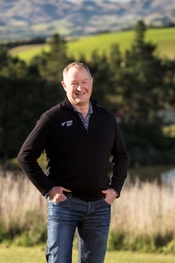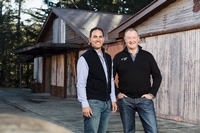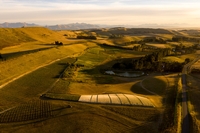Steve Smith is much too modest to say
it or perhaps even to think
it. And may not be happy that others, less-inhibited, may have the audacity to say and think
it.
But Steve Smith, MW, the creative force behind Craggy Range’s rise to preeminence in Hawkes Bay and a former partner there, will say that Burgundy’s fabled terroir and elegant wines are under threat from global warming. And he

will say that he and his business partner, private equity billionaire Brian Sheth, have an undying love for elegant, legendary Pinots Noirs and Chardonnays that come from the hill country to the west side of the Sâone River Valley. And that the Pyramid Valley of New Zealand’s South Island is under little threat of global warming, unlike Europe, and that he and the Sheth in their Smith & Sheth collaboration have the resources, the terroir and hopefully the talent to produce Chards and Pinot in the manner, taste and style that in a few short years Burgundy may no longer be able to execute.
So, connect the lines to the dots, and the resulting picture of
it may look like Burgundy taste-alikes sprouting in lower New Zealand.
It is a lovely day in Soho – New York, not London – in early October, so that Steve Smith and his guests can wander out onto the patio of Sheth’s apartment, one of the American’s homes away from home, where we have been tasting Pyramid Valley wines and having a wide-ranging discussion of many things about wine and the business of wine.
Earlier, before the other guests arrived, Smith talked about how he met Sheth in Hawkes Bay at about the time that he was planning to cut ties with the Peabody family that were his investment partners at Craggy Range. “Brian first came to New Zealand with friends in 2012, and I had dinner with them,” Smith says of their 10-year friendship. “By 2015, I was finishing at Craggy and wanted to take a break, so we began talking. In many ways, Brian and I are different, but in many ways we are similar. We both love sports, and he is a real environmental guy.” In fact Sheth, a first-generation Indian-American from Austin by way of

Boston, and his wife, Adria, established the Sheth Sangreal Foundation dedicated to education and wildlife conservation.
Even more important, Smith says, “We both love Burgundies. He loves drinking good wines and drinking them with other people who really like wine and are not just collecting them [for investment].” Their first venture was Smith & Sheth wines, which was based on the English wine merchant négociant model, buying grapes from the best vineyards and making them into wine.
While that is an interesting business model, it isn’t surprising that the two began looking for a place where they could make their own wines from start to finish

that, hopefully, would rate among the world’s finest. That happened when in 2017 they purchased Pyramid Valley at Waikiri near Canterbury on the South Island after long negotiations with the Wersing family. What Smith and Sheth saw in the property was what Claudia and Mike Wersing saw when they purchased it in 2000 – limestone, clay, and climate.
While the buyers also liked Claudia’s biodynamic approach to the vineyard, they decided to make immediate changes to the winery and winemaking. “I didn’t like using amphorae,” Smith says, citing one example. “It’s too oxidizing and can leave residue. Now we only use amphorae for orange wines.”
“I consider 2020 to be our first vintage at Pyramid Valley,” Smith explains during the tasting. Although he is certainly adept at winemaking, Smith sees himself as more of a vineyard guy, having apprenticed years ago under viticultural guru Richard Smart. So in 2018, Smith and Sheth brought in Huw Kinch, a young winemaker who has modest experience in Burgundy and Napa Valley in addition to New Zealand.
Although it’s still early, the first results from the new venture are very impressive. The three 2020 Pyramid Valley Chardonnays – the “North Canterbury” ($23), the “Field of Fire” ($72) and the “Lion’s Tooth” (also $72) – are stunning, among the best of the thousands of Chards I’ve sipped since 1975. The North Canterbury has penetrating, mineral aromas and tastes, beautiful structure and complex flavors of apples, quince and pears. The Field of Fire exhibits a lovely, Burgundian gaminess (didn’t finish malo, Smith says), while the Lion’s Tooth is more-reticent, needing time in the bottle or glass, and leans to the citrus side of the spectrum.
Are they Côte d’Or replicas? Of course not. But if you want a Chardonnay outside of Burgundy that reflects the Burgundian style and the Burgundian approach while exhibiting similar yet different environmental characteristics, I would start at Pyramid Valley. And I would start while the prices are still reasonable.
However, to me the Pinot Noirs are less impressive, showing a muddled fruitiness that does not draw me in the way a great red Burgundy would; nevertheless, Smith says that Kinch is most fond of his reds.
Having followed progress as California winemakers in the 70s, 80s and 90s tried unsuccessfully to emulate Burgundy with their Pinots, I realize that many people say, “Why bother to try?” With California, I agree. There have been some “closes,” but California Pinots have their own styles, and the best ones will not be mistaken for great Burgundies. The same with Chardonnays. But what if your terroir and climate can put you on similar footing to Burgundy, and you have the skill and resources to do so, why not try to make something as good as the best – Burgundy, of course – or even surpass it?
Once you think about it, that idea of it is not all that audacious. Napa Valley has long been making Cabernet blends that can pass for top Bordeaux reds and are happy to claim equal status. England in just a very few years of existence claims it is challenging Champagne sparkling wines. And many critics think that Marlborough makes the world’s best Sauvignon Blanc, although I’m not one of them. Of course, we do have this reverence for Burgundy – or at least I do – like a little brother or sister that we want to defend from any competitive attack or even comparison, but we should give that up.
Smith will himself go as far as saying, “Burgundy is going to keep getting warmer and also more expensive. And where else does it have to go?” The Hautes-Côtes make good wines, but no one in Burgundy suggests the cooler, higher hills there are the answer. Smith is also understandably excited about New Zealand’s possibilities. (Remember, New Zealand has been making serious wines for only a few decades and still is in the late discovery process.)
“We are never going to get way too hot,” Smith observes. “We’re an island surrounded by water, which tempers things. No one else has that. In degree days, we’re more similar to Champagne than Burgundy.” As an aside, one of the best – perhaps the best – Pinot I’ve tasted outside of Burgundy was a Côteaux Champenois, so having a climate more like Champagne than Burgundy may be helpful in both the short and long run.
So, if Smith and Sheth have great results from their first vintages of Pyramid Valley Chardonnay and potentially Pinot Noir (not discounting the prior efforts the Wersings), and if they have the terroir and possibly the talent, and if they know that the “real Burgundy” is already having warming problems, why not connect the lines between the dots?